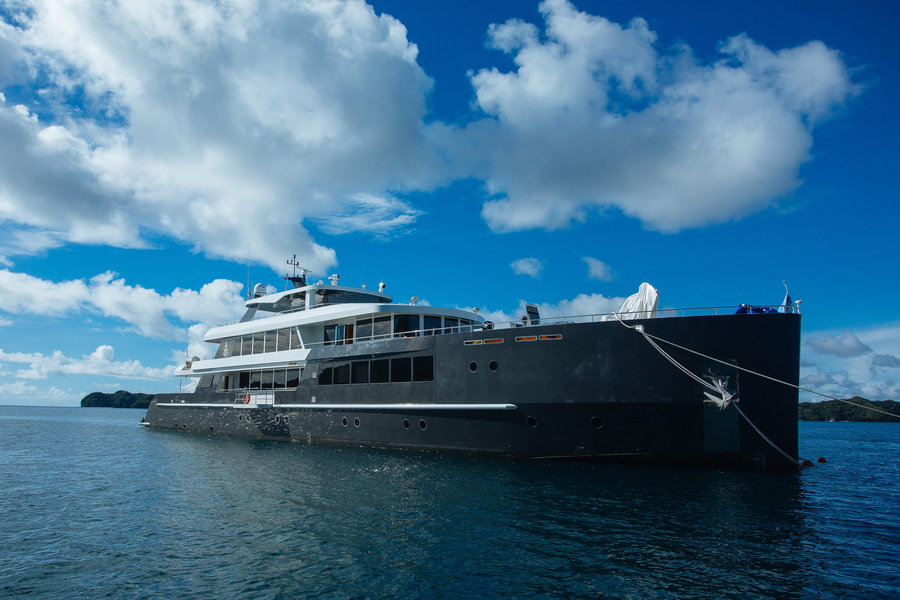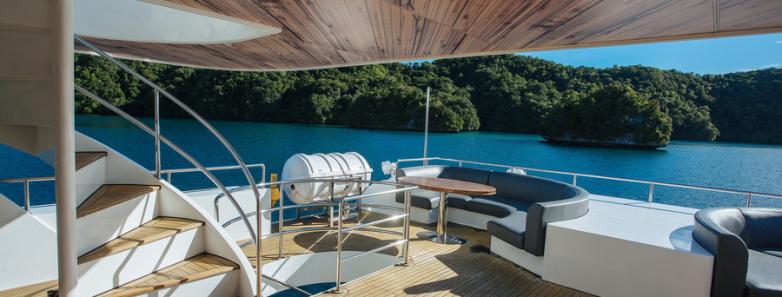Scuba Diving in Palau
Palau diving highlights
An idyllic paradise above and below the surface, topside Palau treat scuba divers to the archipelago's emerald green jungle-covered rock islands surrounded by clear turquoise waters.
CHECK OUT OUR FEATURED PALAU LIVEABOARD?
The M/Y Black Pearl is a premium 46-meter yacht perfect for exploring the waters of Palau. Outfitted with the latest navigation, safety, and scuba diving systems and equipment, the Black Pearl and its crew provides state-of-the-art amenities paired with a pristine and luxurious design.
Jump to:
Marine Life & Environment - Best Dive Sites - Diving Conditions
How to Get There - Best Time to Dive - Practical Information
Looking to book a trip? View Dive Resorts in Palau or Liveaboards in Palau (availability and online booking)
When to Go
Palau scuba diving is great year-round, however, the dry season which lasts from October to May is considered to be the best time to dive Palau.
More on the best time to dive Palau
Palau liveaboards and dive resorts
Palau scuba diving can be done via liveaboard or dive resort. There are a good number of dive resorts and liveaboards to accommodate all kinds of budget. However, if maximizing the amount of time spent diving is your priority, a liveaboard is your best option. Liveaboards often include up to 5 dives per day, while most resorts would offer 2 to 3 dives per day.
Palau is often visited in conjunction with Yap and Truk Lagoon.
View all Dive Resorts in Palau or Liveaboards in Palau.
Diving Information
Marine life, diving conditions, and best dive sites.
Intro to Palau diving
Palau scuba diving involves a lot of drift dives and reef hooks. After your descent, typically 50 to 60 feet, your dive will continue as either a gliding drift over the reefs and along walls as the current carries you, or you will stop and anchor yourself to a sturdy outcropping of rock and let the current bring the reef life to you. A reef hook is essentially a big fishing hook with the barb removed attached to a 3-5 meter rope.
The hook goes into a dead part of the coral reef and the other end attaches to your BCD. Reef hooks are fairly well accepted in Palau, but only at specified sites that have consistent current and an abundance of dead coral to hook into.
Perhaps the most popular of all reef hook dives are at Blue Corner, where a lot of current around the point brings in the big fish. Sharks, jacks, tuna, and resident Napoleon wrasse are often sighted. If mantas are what you seek, head out to the German Channel, where divers rest on the ocean floor while teams of mantas circle above. Palau has a lot of healthy hard coral and a good amount of wall diving.
A typical day of diving in Palau usually involves up to 5 dives a day including a night dive on liveaboards and 2 to 3 dives per day if you stay at a dive resort.
Marine Life & Photography Subjects
It can be difficult to get reef sharks to come close to you while you are hooked in at Blue Corner. Unhooking and swimming down into or over the lip of the reef can get you closer to sharks, but you also risk the ire of other dive groups who fear your bubbles will scare away the wildlife. It's best not to chase sharks - instead, find a good spot where they can swim by you in the current.
Night dives are often the best time to put on your macro lens, as a wide range of reclusive creatures emerges from the reef after dark. This can also be a great opportunity to get close to otherwise skittish fish while they sleep.
Diving Conditions
- Water Temperature: 81-84 degrees Fahrenheit
- Visibility: Ranges from 50 - 150+ feet. During the dry season, the visibility is often in excess of 100 feet.
- Depth Range: 5m - >40m (16 - >131 feet)
Palau's Best Dive Sites
We've rounded up some of the best dive sites in Palau. These sites are typically usually included in most liveaboard itieneraries.
1. CHANDELIER CAVE - This site is a large cave with several “rooms”. You can enter the cave at 25ft, and surface in several different “rooms”. Underwater tunnels allow you to swim from room to room. This is a very cool place, and a good place to take a wide-angle photo with a diver.
It's a very adventurous dive that must be done at the right time of day with an experienced guide with whom you feel comfortable. Bear in mind that this is an overhead environment—there are places where you can’t see any light, visibility can drop to zero, and you can have trouble finding your way out. For all of these reasons, this dive should be taken seriously, and participants should be experienced divers, equipped and trained accordingly, preferably at least cavern certified. It’s also wise to come equipped with lines & reels as well as backup lights, unless you’re sure that the dive operator will provide them.
2. GERMAN CHANNEL - German channel is famous for its manta rays, but it has much more. This narrow pass separates Ngemelis and Ngercheu Islands, forming a connection between the inner lagoon and open sea. Shallow water, strong currents, and boating traffic make the narrowest portions unsuitable for scuba, but the large area at the channel’s mouth offers amazing diving opportunities.
Virtually every sort of tropical marine life can be seen here, but the site is most famous for mantas, eagle rays, reef sharks and many species of schooling fish. Often the best strategy involves settling in a lively area and waiting for the action to come to you. If the current is running, this can also be a great drift dive—just go with the flow and soak up the sights as you fly effortlessly over the reef. Be extremely cautious when surfacing, however, as boating traffic can be very heavy here—make sure that at least one member of your team sends up a safety sausage (SMB) on a line before your final ascent!
3. JELLYFISH LAKE - Jellyfish lake is a must-do in Palau. The jellyfish do not sting. There are lots and lots of jellyfish. Accessed by a short hike on a well-marked trail over a jungle-covered ridge, this marine lake is largely isolated from the surrounding sea.
Read more about swimming and photographing Jellyfish Lake in Paul & Lisa Hogger's account.
However, the water remains connected to the outside by a huge network of fissures and channels in the porous limestone, allowing the tide to rise and fall inside the lake as it does in the surrounding lagoon. Scuba is not permitted in the lake, nor is it needed, as snorkeling is perfect for observing and photographing the famous golden jellyfish, which stay near the surface to maximize exposure to the sun. Sunlight is critical to their survival since they obtain much of their energy from photosynthetic algae living in their tissues. In fact, the jellies actually migrate across the lake on a daily basis, following the sunlight and avoiding shade.
Contrary to popular belief, these jellies have not completely lost their stinging ability, but it is so mild as to be unnoticeable except on sensitive tissue like lips, or for individuals with unusual sensitivity. While the jellies are the main attraction, the mangrove-clad shoreline is also home to a healthy community of anemones, sponges, and tunicates, as well as gobies and other small fish.
4. BLUE HOLE / BLUE CORNER - These two sites are among the most celebrated in Palau, for good reason. Known throughout the world for its abundance of fish life, Blue Corner is the kind of place where it’s possible to see just about anything.
Situated on a current-swept corner of a steep drop-off, it’s a natural gathering point for reef fish of every description, dense schools of jacks, snappers and barracuda, and a healthy population of white-tip and gray reef sharks, as well as Napoleon wrasse and many other species.
Eagle rays, mantas, turtles, tuna and wahoo are also seen fairly often, and even billfish, whale sharks and whales make occasional appearances. Within easy swimming distance (depending on the current) is the sister site of Blue Holes. A large cavern with multiple entrances, accessible from the shallow reef top as well as deeper points on the wall. Illuminated by shafts of sunlight from overhead, the view from inside is a memorable experience of sublime beauty.
The spacious main cavern is appropriate for divers of all experience levels, but there’s also a narrow cave at 85 ft. that should only be explored by properly equipped and certified cave divers. The reef itself is another attraction surrounding both sites, with colonies of boulder and cabbage corals scattered over the plateau at 45 to 60 ft. Dropping over the wall, you’ll find a healthy mix of hard and soft corals, as well as sponges and massive gorgonian sea fans.
OTHER PALAU DIVE SITES - Other notable Palauan sites include New and Big Drop Offs, Ulong Channel, Peleliu Wall, and Cut, Mandarinfish Lake and WW 2 Japanese shipwrecks Iro and Sata. There’s also a Zero fighter plane in very shallow water, plus countless other reefs and walls.
BEST TIME TO DIVE PALAU
In general, Palau can be dived year round.
The best time to scuba dive Palau is during the dry season from October to May. The rainy season from June to September brings more wind and rain than usual, though much of it occurs at night. Palau is in the tropics so it does receive a fair amount of rain, but weather patterns here are fairly predictable.
travel information
How to Get to Palau
Several airlines departing from the western United States make 1 stop and then continue on direct to Koror in Palau (ROR). Once you land, you can basically get on the boat and start diving.
Other Things to do in Palau
Palau offers a host of exciting and adventurous non-diving activities including waterfall hikes at Ngardmau, rock island excursions, sport fishing, speedboat & kayak tours, city tours and more. If you seek nature, kayaking in calm blue waters among the islands is a must-do activity on your non-dive day. Palau is rich with World War II history.
For history buffs, a trip to Peleliu Island or the German Lighthouse is recommended. The Palau Pacific resort is convenient as a 1-2 day stop either before or after boarding a Palau-based liveaboard boat. It’s the islands biggest luxury resort with a lovely private beach.
Liveaboards in Palau
See the availability of liveaboards in Palau and book online. Best price guaranteed. No credit card fees.
The rates shown below are per person in USD some operators may quote in a different currency and the final pricing may vary depending on the latest exchange rates.
Please contact us for the latest availability of the M/V Discovery Adventure.
Other Useful Information
Practical Information
- Currency: United States Dollar
- Language: The official languages are English and Palauan
- Main Airport Code: ROR
- Time Zone: UTC+9
- Electricity: 120 V 60 Hz
Got Questions? Ready to Book?
Call us today at +1-310-915-6677 or email us info@bluewaterdivetravel.com
And let us book your dream vacation!
















































